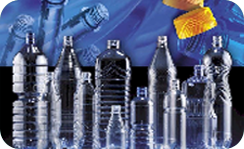OPTIMIZING COOLING PARAMETERS
There are several ways to get the optimum cycle for your molder because there are so many factors determining it.
1. Process
Optimum cooling water pressure is 6 bar or 90 psi. If you don't have that, get it. Upgrade your central chiller or install individual pressure boosters (see previous tips)
Cooling water temperature cannot always be lowered to the lowest possible. Some containers freeze off on ribs and do not fully form when the water is too cold. It is also very disruptive for any blow molding operation when the temperature and cycle time has to be continuously adjusted during high humidity times. I recommend to go with 50º to 55º F water (10º to 12º C).
Lower the melt temperature to the minimum then increase by 10º F (5º C). Record this temperature and monitor it.
2. Machine
Dry cycle times of machines vary wildly and are mostly dependent on the size of the machine. There is usually room to optimize the proportional or mechanical controls of the carriage movement. Choose a setting that does features a short cushion without the carriage banging against the end stops.
While the blow pin down movement is usually a function of the process, the up movement is mostly not, unless you have a Robo-pick underneath your molds. Try speeding it up, it helps the cycle time.
Most machines are controlled in such a way that the mold 'waits' in the open position with the carriage up until the cycle timer runs out. Then the mold closes and a new cycle begins. This waiting time should not exceed 0.3 s on most machines. To adjust it, reduce the cycle timer in 0.1 s increments until the machine goes into the safety cycle time alarm. Then add 0.2 s to the cycle timer on double sided machines and 0.35 s on single sided machines. If your machine does not seem to react and instead the mold closes as soon as the carriage is up, the machine is running off the switches without a cycle timer control. Get this corrected because it leads to inconsistencies in the process as the sum of the machine functions will vary from cycle to cycle.
Reduce the exhaust time. Most machines run with unnecessary long exhaust times because nobody experiments with it. There are two machine control modes out there. The older one starts the exhaust time after the blow time has timed out. After that the blow pin up lift 1st step ('kick-back') is started. Some newer machines start both exhaust and blow pin up 1st step at the same time. In either case you have to decide if you want to avoid the noise that is associated with the blow pins going up before the pressure in the mold cavity has been exhausted. It does not affect container quality as long as the mold is closed at this time. Either way, reduce the exhaust timer until the machine gets too loud or the bottom of the bottle blows out. Then add 0.1 s.
OPTIMIZING COOLING PARAMETERS
Look for timers that are on for no purpose. A favorite is the carriage up delay timer. This timer is needed in some applications with tie-bar machines when the bottle drops too slowly and would be hit by the tie-bar when the carriage goes up. However, most bottles are out of the way by the time the mold is open and the timer can be set to 0. Another candidate is the delay mold close timer.
3. Molds
Material selection is critical. For PE the standard is now an Al alloy with Berryllium-Copper bottom and neck inserts. Most PVC molds are made entirely out of Berryllium-Copper. Stainless Steel holds up better but conducts heat a lot slower. Blow pin tips should always be Berryllium-Copper.
Usually the container neck and bottom are the parts with the thickest wall. Therefore they need special attention. The cooling channel around the neck should be shaped like a horseshoe with a distance of approx. 5/64" ( 5 mm) to the T-dimension of the neck. This will avoid neck distortion. The channels for the bottom insert should also be as close as possible to the cooling ribs.
On multi-cavity molds I still see a lot molds where the water enters on one side and leaves on the other. Of course the first cavity gets the coldest water and the last cavity the warmest, leading to inconsistencies and forcing you to adjust the process to the warmest bottle. While this is acceptable for the mold body, both neck and bottom need a distribution channel in the back plate with a balanced feed to each cavity.
Next month I'll go through an action plan for your next mold qualification. See you then.

 The experts at Apex Container Tech Inc. are here to assist you in your current business or with starting a new one
The experts at Apex Container Tech Inc. are here to assist you in your current business or with starting a new one
 The experts at Apex Container Tech Inc. are here to assist you in your current business or with starting a new one
The experts at Apex Container Tech Inc. are here to assist you in your current business or with starting a new one









